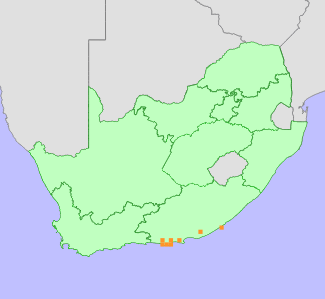|
Scientific Name | Bobartia macrocarpa Strid |
Higher Classification | Monocotyledons |
Family | IRIDACEAE |
National Status |
Status and Criteria | Vulnerable A2c; B1ab(i,ii,iii,iv,v)+2ab(i,ii,iii,iv,v) |
Assessment Date | 2021/08/12 |
Assessor(s) | D. Raimondo & T. Patel |
Justification | This species has an extent of occurrence (EOO) of 6961 km², and an area of occupancy (AOO) of 52 km². It is known from nine extant locations. About 26% of the grassy habitat where this species occurs has been transformed over the past 36 years. There is a continuing decline throughout its range due to crop cultivation and commercial forestry plantations. The generation length of this species is estimated to be 15 years. A minimum of a 30% decline in this taxon is inferred over its whole range in the past three generations (45 years). It is therefore listed as Vulnerable under criteria A and B. |
Distribution |
Endemism | South African endemic |
Provincial distribution | Eastern Cape |
Range | It is a local endemic of coastal Eastern Cape, South Africa, from Humansdorp to East London and Grahamstown. |
Habitat and Ecology |
Major system | Terrestrial |
Major habitats | Algoa Sandstone Fynbos, Kouga Grassy Sandstone Fynbos, Tsitsikamma Sandstone Fynbos, Suurberg Quartzite Fynbos |
Description | It occurs in flat open grassy fynbos. |
Threats |
| This species has lost 26% of its habitat (calculated using land cover data in GIS). Pine plantations pose a threat in Surrey Hills, while agriculture, particularly the transformation to pasture, is a severe threat in Kareedouw and from Humansdorp to Port Elizabeth. Over 60% of the grassy fynbos in this stretch has been transformed since 1970, which is less than three generations ago for this long-lived, bulbous species (Humansdorp farmers, pers. comm.). Notably, there are no collections from this area post-1975, possibly indicating the loss of these sites to transformation (D. Raimondo).
Considering the habitat loss around Humansdorp, Kareedouw, and Port Elizabeth, there is an inferred minimum decline of 30% in this taxon across its entire range in the past three generations (45 years). |
Population |
This species is locally common in its habitat. There are three subpopulations known to remain on fragments, and six others known to exist through historical records. The grassy fynbos at all other locations known through historical records have been completely lost to timber plantations, agricultural expansion and infrastructure development. As a result of ongoing habitat degradation and loss, we infer a continued decline.
|
Population trend | Decreasing |
Assessment History |
Taxon assessed |
Status and Criteria |
Citation/Red List version | | Bobartia macrocarpa Strid | VU A2c; B1ab(ii,iii,iv,v) | Raimondo et al. (2009) | | Bobartia macrocarpa Strid | Insufficiently Known | Hilton-Taylor (1996) | |
Bibliography |
Goldblatt, P. and Manning, J.C. 2000. Cape Plants: A conspectus of the Cape Flora of South Africa. Strelitzia 9. National Botanical Institute, Cape Town.
Goldblatt, P. and Manning, J.C. 2020. Iridaceae of southern Africa. Strelitzia 42. South African National Biodiversity Institute, Pretoria.
Hilton-Taylor, C. 1996. Red data list of southern African plants. Strelitzia 4. South African National Botanical Institute, Pretoria.
Raimondo, D., von Staden, L., Foden, W., Victor, J.E., Helme, N.A., Turner, R.C., Kamundi, D.A. and Manyama, P.A. 2009. Red List of South African Plants. Strelitzia 25. South African National Biodiversity Institute, Pretoria.
Strid, A. 1974. A taxonomic revision of Bobartia L. (Iridaceae). Opera Botanica 37:1-45.
|
Citation |
| Raimondo, D. & Patel, T. 2021. Bobartia macrocarpa Strid. National Assessment: Red List of South African Plants version 2024.1. Accessed on 2025/10/15 |
 Comment on this assessment
Comment on this assessment


